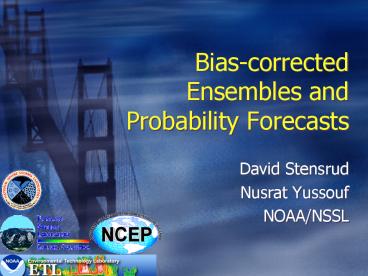Biascorrected Ensembles and Probability Forecasts PowerPoint PPT Presentation
1 / 25
Title: Biascorrected Ensembles and Probability Forecasts
1
Bias-corrected Ensembles and Probability Forecasts
- David Stensrud
- Nusrat Yussouf
- NOAA/NSSL
2
Goal of New England Project
- To improve forecasts of temperature over the New
England region during the summertime, with the
end result being better electric load forecasts. - Focus upon the day 2 forecast time period.
3
Difficult Challenge!
Meteorologists used to just worry about weather.
Now we also worry about Soils Vegetation Radiatio
n Oceans
4
Ensemble Approach
- Ensemble Group of forecasts valid over the same
region and the same time period. - Different initial atmospheric states
- Different models or model details
- Bias correction Take each ensemble member and
correct the forecasts for tomorrow based upon
past information. - Bias-corrected ensemble (BCE) Apply bias
correction to each forecast from an ensemble.
5
Different Initial States
Ability to observe details in structure is limited
Thus, we can vary the structure to within the
uncertainty of observations
6
Different Models or Model Details
- Models are created from similar designs and
concepts, but with different needs in mind. - Kind of like the automobile industry. Basic
design is the same, but details very different.
7
Forecast Models
- NCEP Short-range ensemble
- Eta Model (32 km, 10 forecasts)
- Regional Spectral Model (32 km, 5 members)
- NCEP Eta Model (12 km)
- FSL RUC (20 km and 13 km)
- FSL WRF (20 km and 13 km)
- NSSL Eta (22 km, 2 members)
- 22 Forecasts Total!
8
Ensembles Benefit from Better Models and Initial
States!
3h CAPE (convection) forecast valid 0000 UTC 21
April 2004
Operational RUC
Revised RUC
- Two revisions to RUC
- Better use of METAR observations using
boundary-layer depth - Assimilation of GPS precipitable water
observations
9
SREF Warm Season Case StudyJuly 22, 2004 09 Z
Forecast (51h Forecast)
Prob. Precipgt1 in 48 h
Experimental ensemble with enhanced diversity in
model details
Operational
Operational
Prob. Precipgt1 in 48 h
Observations
Experimental
Experimental
10
Bias-corrected Ensemble (BCE)
11
BCE Results - Basics
- Take average of all 22 bias-corrected forecasts
of temperature and dewpoint temperature in the
ensemble - Compare against present statistical guidance
(MOS) from Eta, AVN, and NGM models.
12
D
N
BCE mean is as accurate as any of the MOS
forecasts for temperature and more accurate for
dewpoint temperature. Advantage is that the BCE
approach is easy and fast to implement once you
have an ensemble.
D
N
D
13
BCE Results - Probabilities
- While present operational guidance gives specific
values for todays high temperature, an ensemble
system provides probabilities for any event or
threshold you choose.
14
Ensembles typically are more valuable for
unlikely events.
86 F
15
Value Added!
80 F
92 F
How would you use this type of information?
16
Cost-Loss Problems
- Using forecast information, decide to either take
action or not take action, and calculate the
costs of the various decisions. - Example Do you need to turn on gas turbines to
provide electric power to your customers based
upon temperature forecasts for tomorrow? Or do
you just buy the power off the grid when needed?
17
Assumptions
- Threshold temperature for needing additional
electric power from other sources is 88 F. - Cost to purchase this outside power over the grid
is 100K. - Cost to turn on gas turbines and provide power is
20K. - Assume that you turn on gas turbines when
forecast temperatures are above 88 F. - Lets look at Boston during summer of 2004. Real
data!
18
Costs Reduced
- 30 periods with T gt 88 F!
19
Not Bad!
- Using no weather forecast information leads to
costs of 3M for purchasing needed power from the
grid. - Using present MOS guidance, you can save 800K by
turning on gas turbines. - Using bias-corrected ensemble data, you can save
1.14M! Thats a 42 increase in savings over
MOS.
20
Why is the ensemble better?
- Ensembles are better because they include
information on uncertainties. - We dont have a perfect picture of the
atmosphere, and our forecast models are not
perfect. But some models and/or pictures of the
atmosphere have greater skill than other models
in certain scenarios. Ensembles take advantage
of this situation.
21
Importance of Variety
Initial conditions
Model diversity
22
Conclusions
- Bias-corrected ensembles can provide improved
forecasts of T, Td, and winds over New England. - Especially valuable are the probability forecasts
that are a natural outcome of using ensembles.
23
Conclusions
- Simple cost-loss example illustrates potential
economic value of using ensemble probability
information in power load forecasts.
24
Future
- Programs like NEHRTP can continue to improve
model forecasts by identifying and correcting
errors in model formulations and assisting in the
inclusion of new data sources - Value of ensemble approach is clear and needs to
be recognized as such. We have much to learn
about how to create and use ensemble data. - Post processing of model data, such as the
bias-corrected ensemble approach, needs to be
regular part of model dissemination process. - How do we make NEHRTP-like programs better?
25
Potential?
Cost for power if forecasts are perfect!

